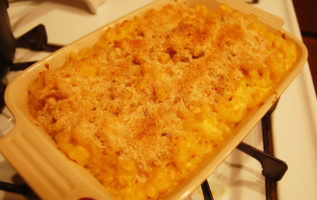
In the culinary universe, pasta should be as easy to make as a peanut butter and jelly sandwich. But if you’ve ever ended up with noodles that are flaccid and flavorless, something has gone awry. Many of us have been there. In fact, when I’m giving personal cooking lessons, I’m continually amazed at how many people bemoan the fact that their pasta never tastes quite right.
It doesn’t have to be this way. And after reading this, you’ll be equipped to make perfect pasta every time. Yes, the two main steps for turning dry, Italian-style pasta into a meal are boiling water and submerging the noodles. But for the perfect pasta, the devil is in the details. And so is the flavor, texture and even how well those oodles of noodles will hold their sauce.
Want the secret to restaurant-quality pasta? Put on some good music (Andrea Bocelli, perhaps?), and follow these five easy steps:
1: Get a big enough pot and add enough water. For a standard 12- to 16-ounce package of pasta, you should use about 4 quarts of water. And that’s good for all types of pasta, from rainbow-colored rotini to good old spaghetti.
2. Rolling boil. Those two words are crucial for the perfect pasta, and it means you want to get that water boiling with a vengeance. Remember, when you put the pasta in the water, heat will dissipate. This isn’t good because it slows everything down, like those scenes in “The Matrix.” The hotter the water, the faster it will recover and return to a boil. A rolling boil looks just like it sounds: The water is so hot it is rolling up toward you, displaying its angry bubbles and undulations. It’s saying, “Hey, don’t make me do this alone! Add something good to me!” Well, you’re about to. And remember, use a lid on the pot to bring it to a boil faster.
3. When your water is at a rolling boil, don’t dump in the pasta just yet: First, add salt. Why? Because salt help brings out the flavor of things, including pasta, which isn’t exactly known as a very flavorful thing to begin with. (Others might also tell you it also affects the boiling point of water, and will help pasta cook more quickly. If so, great. But the real focus here is flavor). Unless you are super carefully watching your sodium intake, you can add up to a small handful of salt. In Italy, they like their H2O to be equal to seawater in salt content. And there’s one more “secret” ingredient: Add about a tablespoon of vegetable oil to the boiling water; it will help prevent the pasta from clumping. (As some readers have pointed out, oil is optional; though it might help prevent boil overs. Experiment to see what works for you.)
4. Finally! Add the pasta, but don’t walk away for too long. Stirring is still the best way to prevent clumping. This isn’t like risotto, where you have to do it constantly; about once a minute should be enough. Cook the pasta uncovered and according to the time specified on the box. I like to go on the lower end so it turns out al dente, or “to the tooth.” All that means is the pasta’s texture will be just a tad stiff – and very satisfying.
5. Time to drain. And here is another opportunity to ruin your pasta. At this point, many folks dump the pasta in a colander and promptly rinse with water to “get rid of the excess starch.” Bad move. If you rinse, the noodles won’t be clingy, and that means the sauce will slip right off. Unless you like a pool of sauce separated from your pasta, don’t rinse. The only instance you would rinse is if you are making a cold pasta salad, such as this one, in which you want your noodles extra slippery.
So there you go: five steps to perfect pasta. Pasta is cheap enough that you can put this into practice often, and you’ll be rewarded with hearty, delicious and satisfying noodles every time. You can eat it very simply dressed, such as above with just olive oil, herbs and grated cheese, or with a homemade marinara sauce. Now, as my Italian mother would say, “Mangia!”
Got your own tips or stories for making pasta? Comment below!
Source: iwanttocook.com (defunct blog)


































